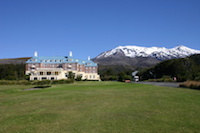 From where I sat, one storey up in a snappy new tourist cabin, the mountain was a sharp, jagged one-dimensional cut-out, the upper reaches white and clean against a sky background that was also white and clean, yet with the vaguest hint of a washed-out blue tinting in it.
From where I sat, one storey up in a snappy new tourist cabin, the mountain was a sharp, jagged one-dimensional cut-out, the upper reaches white and clean against a sky background that was also white and clean, yet with the vaguest hint of a washed-out blue tinting in it.
It was just enough to show the contrast between heaven and earth.
The northern shoulder of the mountain ran away in a long gentle slope, disappearing behind a patch of native bush and somewhat obscured by a scattering of little shops and other buildings close in front of me. But there were also several large, black, rocky, hard-edged spiky lumps high up on the mountain’s shoulder, and while its upper reaches were obviously snow-clad, yet there were still dark areas of scoria indicating the recent smattering was of no great significance.
Across the main crown of the mountain, saw-toothed scallops slashed livid, clean scars against the backdrop of milk-coloured sky all the way to the highest peak, which then swooped down and up again to a more rounded hump, only to drop steeply away south and vanish behind the shoulder of Hauhungatahi, that prominent tussock-covered bulge of land that stands to the west of Ruapehu and broodingly peers down on National Park township.
A short belt of eight scraggly pines partially hid Ruapehu’s crown, but its silhouetted outline showed through, and halfway down the northern shoulder a snippet of cloud peeped over the edge to see whether there was yet any life stirring at the Chateau Tongariro.
What a difference 24 hours can make.
Yesterday morning at this time I had looked out on the same location, peeling the heavy drapes away from the double-glazed windows of the upstairs living area to find myself staring onto a murky, dismal, decidedly cold and moist National Park village that had shrouded itself in dense fog. I could hardly see 300 metres, let alone the 20km to Ruapehu, now so clear and crisp. Yesterday was pull-yer-head-in; today was go-for-broke. Probably, if I was up at the Whakapapa skifield area, I’d be able to see right through to Mt Taranaki and beyond.
So I made the day’s first mug of hot coffee, filched home-baked choc-chip cookies from the plastic container, and settled in to watch the sun rise on the North Island’s highest mountain.
I was only just in time. Within the first few system-starting coffee sips, a kiss of the softest pink lipstick appeared across a north-facing snow slope that ran off the top of the mountain. With infinite patience, the same artist added the same pink tinge to the same little lick of cloud further down the shoulder, then ran a very fine lip-gloss along the edge of the slope all the way up to the northern peak. The very highest peak also received a quick twitch, and the whole top of the mountain took on a true beauty impossible to adequately describe.
Crawling out of bed into a cold dawn that includes hot coffee and a warm gas fire does have its advantages.
But the lovely soft colour lasted only a few minutes, before fading to a pallid yellow, and then was simply gone altogether. The upper slopes were left stark in either white or churlish grey, while the backdrop sky took on the harder, more recognised blue that few of us bother to look at twice.
Yet there were long shadows still, stretching across and down the mountain, and extending way out over the open swamp flats between me and the mountain.
In the little village itself very little moved for the first half-hour, other than a couple of lively flags over an optimistic café, touting for early breakfast business. As well, a hulking huskie-type dog, clad in long, dense off-white fur, took station out on a rock adjacent to the footpath, as he appears to do every morning. He sat very still as he surveyed his personal little fiefdom.
Then, quite suddenly, the sun burst over the small patch of bush not 50 metres from where I sat, surprising me at how far north it was. It was very close to mid-winter solstice, and the sun was about as far along its northern traverse of the eastern horizon as it was going to get. In another week or so it would begin its infinitesimal creep south.
But now, its low, glaring light began to pick out high points and exposed slopes all across the mountain, and slowly the dark shadows vanished and the mighty maunga took on its more familiar three-dimensional frame.
It was obviously cold outside. I hadn’t ventured on to the terrace as I did yesterday to find out just how chill it was, but a steady sou’west breeze was lustily flapping the flags up the street, and the trees and tall tussocks and flaxes nearby were being given a good early-morning workout. Hollows on the muddy ground around the new building I was in had yesterday morning been filled with water and dappled with sleeting raindrops. Today they were brittle with ice.
The chaffinches and yellowhammers, which early yesterday had worked their way diligently across the freshly-bared soil below my window, had obviously chosen to seek breakfast elsewhere this morning. I had heard a blackbird in vociferous praise of the dawn earlier, and now and then a small flock of starlings or sparrows danced across the high blue stage. But people were keeping themselves to themselves.
At 7.35am the village’s fire siren wailed repeatedly in a slow ululation, though I could not see what the callout was about. Forty-five minutes later the fire-truck drew up at the local petrol pumps for replenishment after whatever the activity had been.
That could have been a miserably chilling experience for those gallant volunteers, hosing down a house-fire or a road-accident site with near-freezing water in near-freezing temperatures in a near-freezing wind.
But I guess the people who choose to live in beautiful, peaceful, gently-quiet places such as National Park are also prepared to accept that occasionally there may be a little discomfort with it too.
I admire them – and their surroundings – hugely.
Kingsley Field is a columnist with the Waikato Times in Hamilton. His Outdoors columns appear fortnightly. He has recently published his second illustrated volume of the columns, and is now working on Volume III. He can be contacted at kingsley(at)accuwrite.co.nz









Join the Discussion
Type out your comment here:
You must be logged in to post a comment.